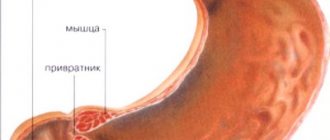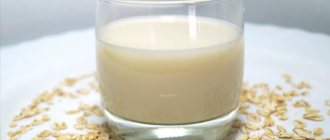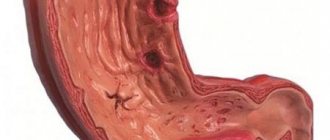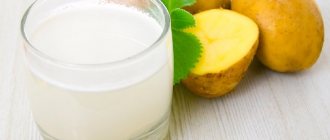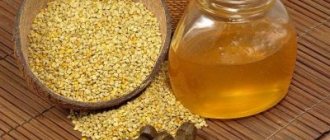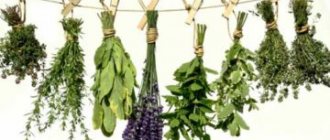Medicinal properties of mint
Peppermint is traditionally used as an anti-inflammatory agent for various diseases. The plant has a beneficial effect on the human body. Among the many properties it is worth highlighting:
- choleretic;
- painkillers;
- calming;
- vasodilators.
In addition, mint has antiseptic qualities.
How can mint help a sore stomach?
- Has antibacterial properties. Chamomile and mint suppress pathogenic microflora and help reduce inflammation.
- The choleretic properties of mint improve the digestion of food.
- Due to the antispasmodic effect, pain is minimized.
- Mint has a mild sedative effect. She relaxes. This is especially important when gastritis is caused by severe stress and anxiety.
Some elements are used in pharmaceutical practice. For example, menthol is an integral component of some medications. In gastroenterology, culture is actively used to treat the following diseases:
- Gastritis in acute and chronic forms.
- Digestive system infections.
- Ductal dyskinesia.
- Diarrhea, stomach ulcer.
The use of mint for gastritis
Mint will be useful for inflammation of the gastric mucosa. Especially for gastritis with high acidity, since it significantly alleviates pathological symptoms, in particular, the juice of the plant relieves nausea well.
Decoction and infusion are used to relieve pain due to increased gas formation and bloating. A drink made from mint, having antimicrobial and antiseptic properties, copes well with the causative agent of gastritis. Most often, peppermint and field mint varieties are used in folk medicine.
Pepper
Peppermint for gastritis is used for increased acidity of gastric juice. It will also be useful for inflammation of the mucous membrane caused by emotional experiences. For gastritis, peppermint helps:
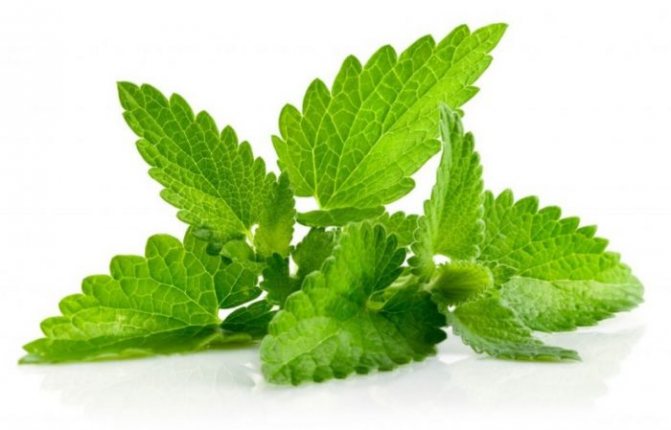
- healing of existing erosions;
- reducing the production of hydrochloric acid;
- relief of pain syndrome.
Advice! Tea with peppermint helps calm your nerves.
The plant is harvested during the flowering period - from July to August. It is advisable to dry the cut branches in the shade.
Field
Field mint is used no less often for gastritis. It differs from peppercorn in having narrower leaves and pink inflorescences located on different tiers of the bush. The plant will be useful for gastritis, accompanied by a low level of acidity of gastric juice. Drinks based on field mint contribute to:
- increased appetite;
- stimulation of secretory activity of gastric receptors;
- eliminating attacks of nausea.
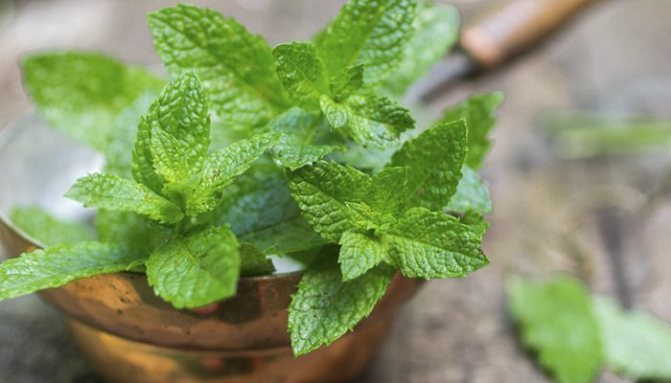
The plant is also used for the development of the following symptoms:
- belching with a sour taste;
- nausea and vomiting;
- increased gas formation;
- pain syndrome;
- unpleasant breath odor.
You can use mint to prepare decoctions, infusions, or simply add it to tea. The plant is harvested in the first summer months.
Does mint treat gastritis?
For stomach gastritis, mint is used in the form of decoctions. It helps perfectly with pain and bloating. Nervous gastritis is often accompanied by asthenic syndrome. The decoction acts as a sedative - relaxes and calms. Warm mint tea, drunk before bed, is a sure cure for insomnia. It can also help people with high nervous excitability.
Why does peppermint really work for gastritis? The plant acts as an antiseptic and antimicrobial agent. It suppresses pathogenic microorganisms and fights the main pathogen - the Helicobacter pylori bacterium.
If you squeeze the juice from the leaves, it can be used to treat colitis and peptic ulcers. This is a powerful remedy with analgesic and antispasmodic effects. Freshly squeezed mint juice is an effective medicine that suppresses attacks of nausea in gastritis with high acidity and peptic ulcers.
Recipes with mint
There are several ways to prepare a remedy from peppermint or field mint. It could be:
- tea;
- decoction
Advice! The recipes use both fresh and dried material - leaves, stems, flowers of the plant.
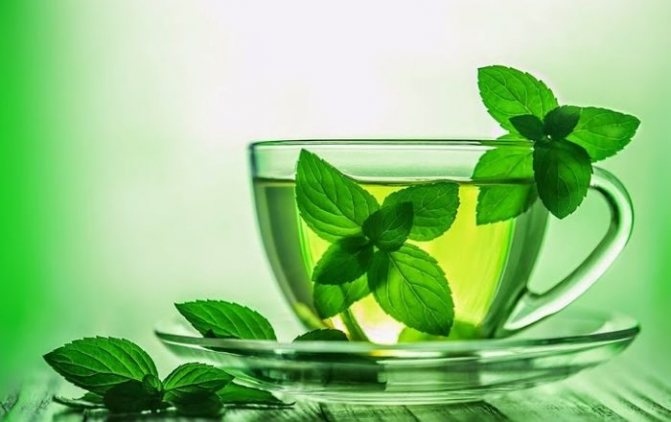
The easiest remedy to prepare is considered a decoction. Due to its antibacterial properties, the drink disinfects the gastric mucosa. You can also use freshly squeezed juice. It relieves pain well, reduces inflammation, and helps cope with attacks of nausea.
Tea
Mint tea for gastritis is an old recipe. Medical research has proven that the drink solves the following problems:
- eliminates pain syndrome;
- stimulates the flow of bile;
- improves the process of fat breakdown.
In addition, mint tea will be useful for increased gas formation, irritable bowel syndrome and other problems that accompany slow digestion. Prepare the drink as follows:
- you need to take dry grass (1 tsp) or fresh mint (1 tbsp) and pour boiling water (200 ml);
- leave for 10 minutes, squeeze out the pulp and filter.
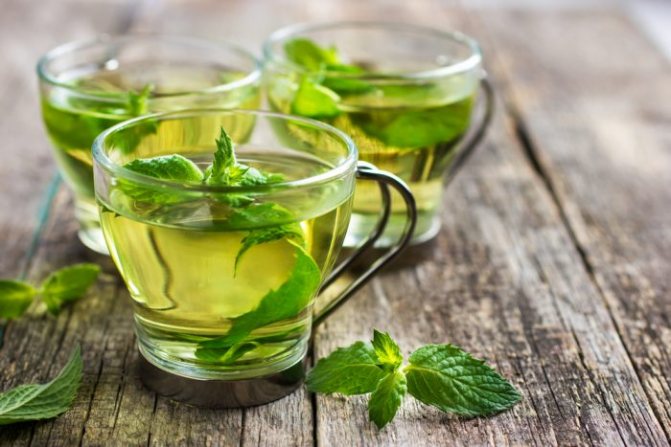
The product should be taken in the morning before breakfast and in the evening before bed. The duration of the course is until the condition improves and the disease goes into remission. Brew fresh herb leaves (50 grams) in 200 ml of boiling water.
Leave for 1 hour and filter. Drink a tablespoon 3 times a day. The duration of treatment is until the pathological symptoms are eliminated. If necessary, the course of therapy can be carried out several times a year.
Decoction
Mint decoction is a worthy alternative to medicinal tea. Preparation:
- you need to mix two varieties of mint in equal parts;
- Pour 2 tablespoons of the mixture into a glass of water and bring to a boil - cook for 5 minutes;
- leave the drink for 10 - 12 hours in a warm place - you can pour it into a thermos;
- strain the broth and take 1 tbsp. three times a day.
The duration of the course is at least 10 days.
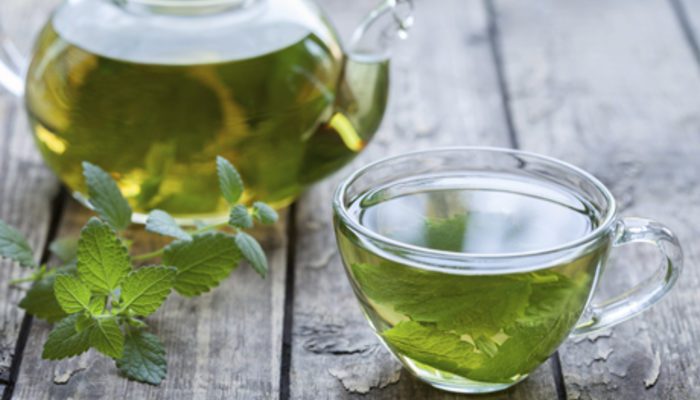
Stomach pain: how to treat pain with folk remedies
Abdominal pain can be caused by a number of serious diseases, not least of which are gastritis, ulcers and pancreatitis. Folk remedies for stomach illness show quite good results, but they must be used carefully.
Many herbs and other natural ingredients for the treatment of intestinal diseases have a number of contraindications and can cause serious side effects. Therefore, in order for the therapy to give only positive results, first of all, the patient should make sure that the possibility of allergic reactions is completely excluded. How to treat the stomach with folk remedies?
Treatment methods for the digestive system
Very often, when we take medications, we become dependent on them. This entails both a financial burden and side effects of medications on other organs in the body.
In order for abdominal pain to stop and no longer bother the patient, it is necessary to consider all the most effective methods of treating diseases of the digestive system. You can get rid of many diseases without pills and doctors, using alternative medicine methods.
Traditional ways to get rid of gastritis
To eliminate the dangerous and unpleasant symptoms of this disease, you can resort to the use of the following medicines of natural origin.
Vegetable oils for gastritis
In order to get rid of stomach pain with the help of this medicine, you need to drink 200-400 ml of still water in the morning on an empty stomach. Wait 7 minutes, then take 30-50 g of olive oil. After a few days, this product can be replaced with another, the main thing is that it is of plant origin.
It is important to know that olive oil has a powerful choleretic effect, which results in a laxative effect. In order not to cause severe diarrhea, it is necessary to take this remedy for the treatment of gastritis only in accordance with the above dosage.
The duration of therapy is 14 days, but to consolidate the results, you need to drink vegetable oils for several more months.
Honey with cow's milk to treat stomach pain
Another effective way to relieve severe stomach pain is a milk-honey mixture. For 2 glasses of warm milk, it is enough to take 4 tbsp. l. fresh or melted flower honey. Drink during the day.
In addition to the main treatment, it is necessary to adhere to a diet that excludes spicy, salty, fried, smoked foods, strong tea and coffee. Duration of therapy is up to 2 months. During this period of time, you can eliminate not only stomach pain, but also completely get rid of the symptoms of gastritis.
It is important to know that if a patient has an allergic reaction to one or both ingredients, then this treatment should be excluded completely in order to prevent the development of serious health consequences.
Do not indulge in evening snacks, as this may reduce the effectiveness of therapy.
Cabbage juice for treating the stomach with folk remedies
This remedy has a positive effect on the intestines and helps relieve discomfort in the stomach. However, it is not recommended for use in cases of high acidity, since cabbage juice contains many natural acids.
https://www.youtube.com/watch?v=JkGcPBEC91s
To prepare the medicine, you need to finely grind the leaves of this vegetable in a blender or food processor and squeeze the juice into a mug. The liquid should be warmed slightly before use. Take half a glass before meals, immediately after squeezing, 2 times a day.
During the procedure, the patient may experience a feeling of nausea. In this case, you need to drink the medicine no earlier than 4 hours after the juice has been squeezed out. The product can be stored for no longer than 48 hours, and only in the refrigerator.
Birch bark for stomach pain
This remedy for stomach pain due to gastritis is advisable to use for heartburn. A decoction of birch bark reduces acidity and eliminates abdominal discomfort, but only if it was prepared correctly.
The method of preparing this traditional medicine is very simple. Chop the bark and place in a saucepan; fill with water at 60 degrees temperature. Let the mixture brew, then filter.
Drink the decoction 3 times a day before meals. After this, after about a quarter of an hour, you need to drink a spoonful of butter, which should first be melted. The course of treatment with this folk remedy is 20-25 days.
If during therapy the patient develops intense stomach pain, belching, discomfort and heaviness, then along with a decoction of birch bark it will be useful to take an infusion prepared from the herb celandine.
How to get rid of pain in the abdomen due to an ulcer
Traditional medicine is widely used to treat peptic ulcers, especially if it is accompanied by increased stomach acidity. The most famous and effective are such recipes.
Decoction of plantain
It is necessary to pour 30-40 g of dry leaves of this plant with 200 ml of boiling water and let it brew. Squeeze out the cake and throw it away, and drink the finished medicine 2-3 times a day before meals as an ordinary herbal tea. If abdominal pain does not go away, then this folk remedy is not suitable for individual reasons.
Honey, butter and walnuts
Treatment with this method should be carried out with extreme caution, since honey is a strong allergen. Place all ingredients in an enamel bowl in equal parts.
Place it in the oven, wrap it tightly and bake the mixture at 100 degrees. Stir and let cool. Take 3 times a day before meals.
The course of treatment lasts until complete recovery. This traditional medicine recipe helps relieve abdominal pain, improves bowel function, and also has a positive effect on the pancreas.
Lemon ointment
Squeeze as much juice as possible from 4 large lemons, then mix it with 1 kg of honey and 1 liter of olive oil. Stir the mixture, cover with a lid and place in a cool place. Periodically, the pulp needs to be shaken so that it does not “candied.”
Take the medicine 1 tbsp. l. 3 times throughout the day before meals. The duration of therapy is 30-35 days, and so 3 courses per year until complete recovery.
Peppermint for stomach treatment
Treatment of stomach ulcers and gastritis using traditional methods can be carried out through the use of peppermint decoction. It helps relieve pain, relieve heartburn, and improve bowel function. This relieves bloating, normalizes sleep and digestion.
The recipe for this medicine is quite simple. Pour 50 g of dry peppermint leaves into a small bowl, pour 400 ml of boiling water and put on low heat. After boiling for 7 minutes, remove the mixture, cool and squeeze. Throw away the cake, and drink 0.5 cups of the finished tea several times a day.
This folk remedy is prohibited for use in cases of low stomach acidity .
Traditional recipes for the treatment of pancreatitis
Pancreatitis is an inflammation of the mucous membrane of the pancreas. In this case, the patient feels severe pressing pain in the abdomen, nausea and discomfort.
To get rid of them, you can resort to traditional therapeutic methods, in particular this applies to medicinal plants. The following herbs are of great benefit for problems with the pancreas and intestines:
- Marigolds, or calendula.
- Field chamomile.
- Peppermint.
- Common plantain.
- Corn silk.
You can brew them separately and take half a glass 2-3 times throughout the day, or prepare a decoction of all the plants at once, taking them in equal proportions.
8 tbsp. l. pour 1.6 liters of boiling water over the herbal mixture, place in an enamel saucepan on the fire and boil for 5-7 minutes.
When the broth is infused, the cake should be squeezed out, and the liquid should be additionally filtered through a tea sieve or thick gauze. Take a quarter glass of the product 2-3 times a day, after diluting it with a small amount of boiled warm water.
This folk recipe, used for diseases of the pancreas, helps relieve pain in the abdominal area and relieve the inflammatory process, due to which the result of its use will be noticeable after 1-2 doses.
You can store the medicine in the refrigerator, but not longer than 5 days. After this time, a fresh infusion should be prepared.
Flaxseeds in the treatment of pancreatitis
Quite often, flax seed is used to treat gastritis or pancreatitis at home.
A decoction prepared from it has an enveloping effect, has a positive effect on the stomach and pancreas, and helps get rid of abdominal pain.
Its taste is quite specific, but for the sake of curing the disease, even if it has become chronic, you can come to terms with this nuance.
To prepare a decoction of flax seeds, you need to pour 2 tablespoons of the raw material with 400 ml of water, put the vessel on the fire and boil. Take 1 cup of coffee every 2 hours until complete recovery.
Stomach drops for pain in the treatment of the stomach with folk remedies
You can also relieve abdominal pain without medication using stomach drops. They are based exclusively on extracts of medicinal plants and medical alcohol, therefore they are absolutely harmless, unless, of course, the patient is allergic. They include:
- wormwood
- peppermint
- belladonna
Take 1 tbsp. l. alcohol tincture for severe stomach pain. This remedy should be used as a regular pain reliever. Therefore, it is not recommended for the treatment of diseases of the digestive system.
There are cases when, after undergoing a course of treatment for gastritis, ulcers or pancreatitis, pain and other symptoms do not go away. This may be a dangerous signal to visit a gastroenterologist . Timely initiation of therapy reduces the risk of developing more severe pathology, which can even lead to death.
Source: https://recipesforhealth.ru/narodnoe-lechenie/lechenie-zheludka-narodnymi-sredstvam.html
Contraindications
Mint has its contraindications. Treatment of gastritis with its help will need to be abandoned in the following cases:
- in case of individual intolerance to the plant;
- with low blood pressure.
Mint has the ability to reduce the tone of venous vessels, so it will be contraindicated for varicose veins. The plant helps eliminate pain in the intestines and reduces gas formation. Mint can be used for gastritis with high and low acidity.
Products based on it can be used for peptic ulcers of the stomach and duodenum. And although mint for gastritis is a completely safe remedy, before you start using it, you should consult with a specialist.
Reviews of mint
My grandmother told me about the miraculous effect of fragrant teas. She often brewed a fragrant drink, explaining how useful this potion was. Now I am already an adult girl, but I still use mint when stressful situations or digestive problems arise.
Herbal preparations are better at fighting heartburn and pain than pharmaceutical products. Menthol infusion is always in my arsenal for overeating, burning and other unpleasant symptoms in the stomach. I recommend to everyone!
Melissa has a gentler effect on the digestive organs. Pure mint is contraindicated, for example, in case of reflux esophagitis. I checked it from my own experience and the sensations were unpleasant. Therefore, it is necessary to strictly follow the instructions even for such a harmless herb.
I really like mint, but only as a seasoning for tea. I tried drinking it for gastritis, but this method did not help me. I can only get rid of the disease with medication.
Using mint in the treatment of gastric pathologies is quite simple. However, it is important to use this medicinal plant correctly, based on the doctor’s recommendations and existing contraindications. Gastritis is a serious disease and the patient’s recovery is only possible with an integrated approach. Don't self-medicate! Be healthy!
How do different types of mint affect the stomach and intestines? Recipes with the plant for various gastrointestinal problems
Gastritis is a disease associated with inflammation of the gastric mucosa. This disease can be caused by poor diet, abuse of alcoholic beverages, fatty, unhealthy foods, as well as long-term use of certain medications, aspirin or ibuprofen.
The health of the body is also influenced by environmental factors and the psycho-emotional state of a person. Inflammation of the stomach lining is a disease that has become quite common lately. Mint for gastritis is one of the best remedies for the stomach. The wild plant is distinguished by its medicinal properties. There are several of its positive effects on the human body:. Mint allows you to reduce the source of inflammation in the stomach, reduce pain thanks to the menthol included in the composition, promotes proper digestion and absorption of food consumed by the body, and also relieves stress as a sedative.
Mint can grow in the wild or be specially grown in an artificial environment. There are several types of plants that have different properties:.
Peppermint is a cultivated plant, characterized by a small height of up to 1 meter and having a green or red-violet, straight or curved stem with pink flowers in a tiered inflorescence, leaves of different configurations: elongated, elliptical.
The main components of the composition are menthol and essential oil. Peppermint oil is used as an analgesic and antispasmodic. It is used for gastritis with high acidity, because it has miraculous properties:
To restore the gastric mucosa, you will need leaves, stems, and flowers of the plant. A decoction is the simplest and most effective remedy that, thanks to its antibacterial effect, disinfects the body. Freshly squeezed juice from the leaves relieves pain, reduces inflammation in the body, and also helps cope with nausea resulting from stomach cramps. This type of medicinal plant grows in the wild, or can be grown artificially.
Field mint has narrow leaves and pink flowers located at different levels. This variety of plant is used for acute or chronic inflammation of the gastric mucosa, helps prevent nausea, improve the digestion process, and eliminate unpleasant odor from the mouth. Decoctions and infusions of leaves dried to powder are a common remedy that is used for pain in the abdomen and stomach.
It relieves spasms, reduces the level of secretion of hydrochloric acid and endocrine glands. Lemon balm is a specially grown plant that has broad leaves and white or yellowish flowers.
The smell is reminiscent of lemon aroma. This type is recommended for use for bloating and stomach pain. Melissa helps reduce acidity levels, relieve pain spasms, and normalize the psycho-emotional state. For gastritis, you should use an infusion or decoction of crushed pre-dried lemon balm leaves.
Swamp ombalo grows in the wild, has oblong leaves, purple or red flowers, and a nut-like fruit. In case of inflammation of the gastric mucosa, it reduces pain, disinfects, improves digestion and, as a result, increases appetite. Before use, you should familiarize yourself with the contraindications: ombalo decoctions should not be taken by pregnant women, children, or people suffering from liver disease. Spearmint has many leaves on the stem, with a twisted shape at the edges.
The cultivated plant reduces antispasmodic pain, prevents erosion of the stomach lining, and also eliminates vomiting. Wild mint oregano is a low-growing herbaceous plant with a green stem, shaggy leaves with a pointed shape, and pink inflorescences in the shape of a brush.
Oregano should be consumed in chronic forms of the disease. You should not take a decoction of wild mint for acute gastritis and peptic ulcers. Contraindications for use also apply to pregnant women. Oregano is an antibacterial agent that relieves pain and helps prevent nausea.
Tibetan lofant is a herbaceous plant with oval-shaped leaves with jagged edges, inflorescences of different shades of white-yellow, blue-violet in the shape of a colossus. Korean mint destroys bacteria in the gastric mucosa, restores and normalizes the digestion process. A gastric ulcer is a disease of a chronic nature, with the typical formation of ulcerative scars on the surface of the stomach. Periods of relapse are mainly spring-autumn alternating with periods of remission.
Over the last decade, the main method of treating the disease has been the eradication of the bacterium Helicobacter pylori, which plays an important role in the development of the disease. The patient's well-being may improve if treated with antacid medications. But most people fight ulcers using antisecretory drugs. You have been diagnosed with a stomach ulcer. The gastroenterologist gave you a prescription for medications and sent you home for treatment.
An ulcer disrupts the integrity of the mucous membrane of the stomach and duodenum. Without treatment and a special diet, the pathological process penetrates into the deep structures of organs, tissue restoration becomes long-term and difficult.
In a neglected state, destructive changes are irreversible. The main cause of the disease is heredity and poor nutrition. Factors that provoke exacerbation include smoking, alcohol, unhealthy and fatty foods, some medications, chronic fatigue, and stress.
In traditional medical practice, a treatment regimen is a balanced set of drugs selected to combat a specific disease. In everyday speech, a similar expression most often refers to all measures, from medications to folk remedies. Our site is designed not so much for professionals as for ordinary patients, so we will try to provide the widest possible information.
Here is a description of standard measures to combat peptic ulcer disease. Usually the disease can be identified during the period of exacerbation: until thunder strikes, the patient will not go to the doctor. Accordingly, the doctor first prescribes intensive therapy, and then preventive treatment to prevent relapse. There are several ways to prepare a medicinal plant to prevent the first symptoms of gastritis: Infusions can be made from pre-prepared preparations for the treatment of gastritis, for example, from fresh leaves and stems of plants.
For gastritis with high acidity, pour 0.5 cups of boiling water over 10 grams of herb and leave for half an hour. It is recommended to add other medicinal plants, such as yarrow, sage, St. John's wort or chamomile. And then take a tablespoon of infusion 3 times a day before eating. To relieve pain, you need to pour 5 grams of the plant with hot boiled water and leave for a quarter of an hour. After the time has passed, consume a tablespoon of the strained drink after 3 hours.
A decoction can be made from both dried and fresh leaves of medicinal herbs. The herb, 5 grams in size, needs to be brewed in one liter of water for 15 minutes. After a quarter of an hour, you need to let the broth brew for half an hour.
After this, it should be strained and cooled. A decoction of Korean or spearmint can be taken once before meals, preferably in the morning, and from lemon balm - every 3 hours, from peppermint - 3 times a day. Mint teas are made from a teaspoon of dried or a tablespoon of fresh leaves of the plant, which must be poured with a glass of hot water and steeped for 5-10 minutes. This drink should be consumed twice a day: in the morning before meals and in the evening after meals.
Tea can also be prepared with valerian roots in the same proportions. Mint is a plant that has medicinal effects that can eliminate pain, spasms in diseases of the gastrointestinal tract and restore acid balance. Infusions and decoctions from the leaves and stems of the herb are traditional medicine recipes that allow you to get rid of the first symptoms of gastritis, but are not the main means of treatment.
Mint is a popular medicinal plant. The beneficial properties of the plant were described by doctors in ancient times. Mint is used for medicinal and culinary purposes. The plant is distributed in the northern half of the globe. Has 25 varieties. Almost all species are wild. One type of herb is cultivated for medicinal and culinary purposes. Mint growing in the wild is not inferior in properties to its cultivated relative.
Ingredients: linden flowers, dried fennel fruits, flaxseed and licorice root in equal proportions. The components of the plant are used in pharmaceutical practice. Menthol is included in many certified medications. Peppermint was bred by crossing two wild species. The main beneficial substance of the plant is menthol, which is part of the volatile essential oil in the leaves and inflorescences.
In folk medicine, mint is used as an anti-inflammatory and choleretic agent. Mint oil, tinctures and drops are industrially obtained from the leaves, stems, and inflorescences of plants. The components are used in medical practice, cosmetology, and the perfume industry. Mint leaves are used for culinary purposes for gastritis.
Decoctions and water infusions from the leaves and flowers of the plant are used for abdominal pain, flatulence, and bloating. A decoction of mint has a calming effect and helps with nervous excitability, characteristic of asthenic syndrome in gastritis. The drink also has an antimicrobial and antiseptic effect and fights the causative agent of the disease. Fresh juice squeezed from mint leaves has an antispasmodic and analgesic effect for gastritis, colitis, and gastric ulcers.
Mint juice is a remedy against nausea, which manifests itself in gastritis with increased secretion and gastric ulcer. The plant is used as a mild sedative, analgesic and antiemetic.
Eliminates signs of inflammation. For gastritis with reduced secretion, mint decoction increases appetite, stimulates the secretory activity of the gastric glands, and relieves nausea.
Mint for the stomach: beneficial properties and therapeutic effects
Mint contains biologically active substances that have a beneficial effect on the mucous membrane of the stomach and intestines. It contains menthol, which relaxes the smooth muscles of the digestive tract. The patient gets rid of spasms and pain. The variety has the following beneficial properties:.
It is considered an excellent digestive aid and may help relieve some of the symptoms of irritable bowel syndrome IBS. It is also used to improve sleep, relieve stress and excessive mental activity, eliminate bad breath and strengthen the immune system.
Mint tea. We've all tried mint tea at least once. Mint tea tastes wonderfully aromatic and healthy. And in summer, in hot weather, it also gives a pleasant cool sensation in the mouth thanks to the menthol contained in mint. Peppermint tea is not only one of the most delicious herbal teas, but also has various medicinal properties. For example, you can use mint tea for sore throats and colds. Mint tea from fresh leaves develops a wonderful aroma, and the rising vapor of mint is very suitable for inhalation. In addition, mint tea has a beneficial effect on the gastrointestinal tract. The essential oils contained in mint provide calming, as well as disinfection of the stomach and intestines.
Peppermint tea against stomach diseases.
Alternative medicine uses many methods to combat gastrointestinal diseases. Among the main additional medicines for gastritis is mint. The aromatic plant not only soothes irritated mucous membranes and normalizes acidity levels. The plant has antibacterial properties, due to which signs of the disease are suppressed and associated phenomena such as heartburn and cramps are eliminated. The aromatic herb can be found in almost every garden; it grows quickly, standing out among other plants for its aggressiveness and unpretentiousness. This fragrant plant contains menthol, which is an essential oil. It is better to collect the medicinal plant before the flower stalks are released; at this time, the leaves and stems of mint contain the largest amount of valuable substances. During the period of treatment with mint, digestion is improved, attacks of nausea are reduced, the emotional background is straightened, and discomfort in the stomach is eliminated.
One of the symptoms of gastrointestinal diseases is inflammation of the mucous membrane. In addition to conventional medications, herbal preparations are successfully used to treat gastritis.
WATCH THE VIDEO ON THE TOPIC: IBS (irritable bowel syndrome), ulcers, gastritis... can be treated with one remedy!


